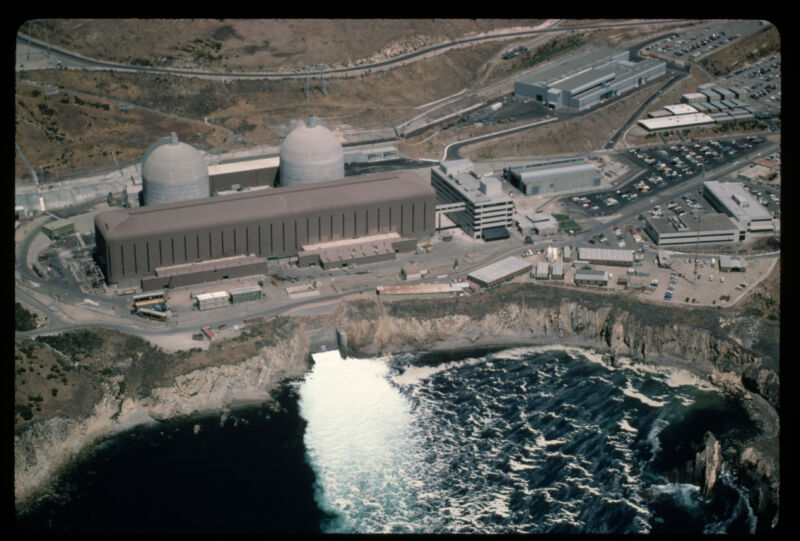

As heat wave threatens power crisis, California extends life of nuke plant
source link: https://arstechnica.com/science/2022/09/as-state-heats-up-california-extends-operation-of-its-last-nuclear-plant/
Go to the source link to view the article. You can view the picture content, updated content and better typesetting reading experience. If the link is broken, please click the button below to view the snapshot at that time.
Some nukes —
As heat wave threatens power crisis, California extends life of nuke plant
Legislature approves plan to give Diablo Canyon another five years.
John Timmer - 9/1/2022, 5:34 PM

On Wednesday, California legislators approved a plan to keep the state's last nuclear plant open until at least 2030. While the timing of the vote was set by the end of the legislative session, it turned out to be symbolic: The state is facing a massive heat wave that is likely to break temperature records and set off a surge in energy demand. Even with the Diablo Canyon plant operating, the state announced a series of measures that are meant to help its electric grid manage the crunch.
Legislature acts fast
Many countries are facing debates similar to California's: Nuclear power provides a significant amount of their carbon-emissions-free electricity, but the plants are less-than-ideally sited, aging, and getting increasingly expensive to operate. Combine that with publics that are often ambivalent about nuclear power, and it gets challenging to keep the plants operating—yet meeting climate goals without the plants is also extremely challenging.
In California, Diablo Canyon became the state's last operating nuclear power plant after replacement boilers at the San Onofre plant started failing early in their planned life span. Diablo Canyon's siting was always controversial—it turned out to be near a fault line that hadn't been described prior to construction, and the cooling water it returned to the nearby ocean disrupted the ecosystems there. Eventually, resistance led to the decision not to seek extended licensing for the plant when its current one expired in 2025.
Meanwhile, the state has been aggressively installing solar generation and battery storage to allow it to meet an evening surge in demand. But heat waves and drought have increased the challenge by straining transmission capacity and lowering generation from hydroelectric plants. These problems resulted in rolling blackouts during recent heat waves.
Would the solar and storage rollout happen fast enough to both compensate for Diablo Canyon's 2025 shutdown and allow the state to reach its climate goals? Apparently, Governor Gavin Newsom decided to do all of the above. In an announcement made in mid-August, he made California's aggressive climate goals even more aggressive: keep the planned expansion of renewables and keep Diablo Canyon open for another five years.
AdvertisementDoing so, however, involved extending a $1.4 billion loan by the state to the plant's operator, Pacific Gas and Electric (PG&E), to offset the cost of renewing its operating license. The loan will be forgiven if the plant can't operate profitably. This loan, and some attendant environmental approvals, required action by the state legislature on a tight schedule. As of Wednesday, the legislature approved the plan; given the whole thing was Newsom's idea, it's pretty certain it will be signed into law.
The backdrop
The timing was auspicious, given the impending heat wave that forced Newsom to take additional actions to ready California's electric grid for the coming strain. The heat wave is expected to be unusual in three ways: It's expected to last about a week, cover most of the West Coast and extend substantially inland to interior states, and it's coming in September, when temperatures usually start to moderate.
Many areas of California are expected to see readings in the area of 40° C (104° F) and set monthly records for high temperatures. This will put critical strain on the state's grid in the early evenings, when solar production fades and people arrive home from work to warm houses and apartments. The general warmth of the climate is going to add to the challenge, in that an extended drought will lower production from hydroelectric facilities, and states that might otherwise export power to California may find themselves using it for their own citizens' air conditioners.
To compensate, Newsom is activating a plan that, among other things, temporarily sacrifices air quality to keep the lights on. Buildings that have auxiliary diesel generators will be able to activate them during the heat wave, and ships docked in port can use their engines to produce onboard power instead of drawing from the grid. The state's power plants can sacrifice some efficiency to maximize output. The state may also call on the home battery reserve that it has been organizing.
Home owners are being asked to run major appliances and pre-cool their homes prior to 4 pm to shift load to when solar production is highest, then make extra efforts to conserve from then until 9 pm. Those efforts include shutting off unnecessary lights and appliances and keeping the thermostat set to 25° C (77° F) during that time.
Recommend
About Joyk
Aggregate valuable and interesting links.
Joyk means Joy of geeK